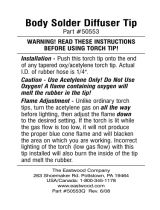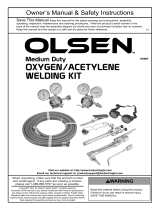
Page 3For technical questions, please call 1-888-866-5797.Item 96290
SAFETYOPERATIONMAINTENANCE SETUP
9. Keep a fully charged fire extinguisher close
by and know the proper way to use it.
10. After cutting make a thorough check for
evidence of fire and be aware the easily
visible flame or smoke may not be present
for some time after a fire has started.
11. Do not cut in atmospheres containing
dangerously reactive or flammable
gases, vapors, liquids, or dust.
12. Clean and purge containers before applying
heat. Do not apply heat to a container
that has held an unknown substance or a
combustible material whose contents, when
heated, can produce flammable or explosive
vapors. Vent closed containers, including
castings, before preheating or cutting.
Personal Safety
1. Wearing and using personal safety clothing and
safety devices reduce the risk of injury.
Wear the following:
a. Fire-resistant clothing (Do not wear pants with
cuffs, shirts with open pockets, or any clothing
that can catch and hold molten metal or sparks.)
b. Fire-resistant leather leggings and work boots
c. Dry, insulating leather welding gloves
d. NIOSH-approved respirator
e. Shade 5 or higher welding goggles
f. Appropriate head covering to
protect head and neck
g. Fire-resistant ear plugs or ear muffs (if
cutting overhead or in confined spaces)
Keep clothing and safety equipment free of grease,
oil, solvents and any other flammable substances.
2. Stay alert. Watch what you are doing, and
use common sense when operating this Torch.
Do not use while tired or under the
influence of drugs, alcohol, or medication.
A moment of inattention while operating
may result in serious personal injury.
3. Do not overreach. Keep proper footing and
balance at all times. Proper footing and balance
enables better control in unexpected situations.
4. INHALATION HAZARD:
Welding and Cutting Produce
TOXIC FUMES.
Exposure to cutting exhaust fumes
can increase the risk of developing certain
cancers, such as cancer of the larynx and lung
cancer. Also, some diseases that may be linked
to exposure to cutting exhaust fumes are:
• Early onset of Parkinson’s Disease
• Heart disease • Ulcers
• Damage to the reproductive organs
• Inflammation of the small intestine or stomach
• Kidney damage
• Respiratory diseases such as
emphysema, bronchitis, or pneumonia
Use natural or forced air ventilation and
wear a respirator approved by NIOSH
to protect against the fumes produced
to reduce the risk of developing the
above illnesses.
5. Avoid overexposure to fumes and gases.
Keep your head out of the fumes. Do not breathe
fumes. Use enough ventilation or exhaust,
or both to keep fumes and gases away from your
breathing area. Where ventilation is questionable,
have a qualified technician take an air sampling
to determine the need for corrective measures.
If necessary, use mechanical ventilation to
improve air quality. If this is not possible, use an
approved respirator. Do not work in confined
areas unless they are well-ventilated or you are
wearing an air supplied ventilator. Always follow
OSHA guidelines for Permissible Exposure Limits
(PEL’s) for various fumes and gases.
Follow the American Conference of Governmental
Industrial Hygienists recommendations for
the Threshold Limit Values (TLV’s) for fumes
and gases. Have a recognized specialist in
Industrial Hygiene or Environmental Services
check the operation and air quality and make
recommendations for the specific cutting situation.
6. WARNING: This product, when used for welding,
plasma cutting, soldering, or similar applications,
produces chemicals known to the State of
California to cause cancer and birth defects
or other reproductive harm. (California Health
& Safety Code § 25249.5, et seq.)
7. WARNING: The brass components of this product
contain lead, a chemical known to the State
of California to cause cancer and birth defects
or other reproductive harm. (California Health
& Safety Code § 25249.5, et seq.)
8. WARNING: This product contains di (2-ethylhexyl)
phthalate (DEHP), a chemical known to the State
of California to cause cancer and birth defects
or other reproductive harm. (California Health
& Safety Code § 25249.5, et seq.)



















